Location, location, location — what’s critical to real estate is also critical to eclipse watching, and without sounding too boastful, those of us atop South Menan Butte, an extinct volcano in southeast Idaho, absolutely nailed it. Not only did we have perfect weather, we had an excellent camping experience, great food, a magnificent natural setting, and a perch 800 feet above a vast plain stretching endlessly to the east and west. Everything was set up for a perfect eclipse experience, and we were not disappointed.
Happy Campers
The eclipse itself was merely the climax of a weekend that just kept giving, and that really started back in January when I started planning this trip. That was when I first wrote about the eclipse and announced that I’d selected Menan Butte outside of Rexburg, Idaho, as my ideal location. It turns out that while North Menan Butte is public land, South Menan Butte is private property partly owned by one Mr. Brent Gunderson. He actually read my Hackaday post and used it to gauge interest in opening up his land to eclipse watchers.
Thankfully, he decided it was worth it, and he and his neighbor pulled out all the stops. I spoke to Brent briefly at the Saturday night meet and greet picnic dinner he threw on the lawn of his house; he was clearly a busy man but still managed to work the food line and serve up some of the best fried chicken I’ve ever had. He clearly enjoyed meeting all the people he had corresponded with for months as they arrived at the campground he had set up in an alfalfa field nestled between his home and the Snake River.
I can’t say enough about Brent’s hospitality — where someone might have been tempted to take advantage of desperate eclipse watchers to extort as much money as possible and provide as little as possible in return, Brent and his family just kept giving. The food, the guidance on local services, the accommodation for the disabled and those unable to climb to the best viewing locations, even the merchandise like T-shirts and eclipse glasses — everything was available either for free or at extremely reasonable rates that I suspect barely covered his expenses. Everyone who camped at Brent’s owes him a debt of gratitude for everything he and his family did for us.
On the Rim
Of course the crown jewel of the experience was the location itself. The Menan Buttes are volcanic cones that were formed about 10,000 years ago, rising 800 feet about the Snake River Plain. I climbed South Menan Butte on Sunday to watch the sun rise and to scout locations for viewing; it was a tough climb but well worth the effort. The view from the top was spectacular, with the Snake River Plain stretching 40 miles to the northwest to the Lemhi Mountains and 20 miles east to the Tetons. The spot I picked was a knob of rock on the north part of the rim, the highest point I could find. I made extensive notes about what I’d need for my expedition and headed back to camp.
When the big day arrived, I set out for the rim at about 4:30 AM. It was still pitch dark, and the unpolluted skies of rural Idaho gave me a lovely view of the Milky Way as I picked my way up the butte. Eyes stared back at my headlight from the sage brush; deer perhaps? Or coyotes. After a hard hour of climbing, I reached my perch and staked my claim, watched another spectacular sunrise, and waited for everyone else to arrive. My son came up first with Chris, a Hackaday reader who also made the trip down from North Idaho and came to our little meetup on Sunday night. My daughters came up next, then my wife bearing breakfast sandwiches for us all. Nothing makes simple food test better than being outdoors.
It was cold while we waited — in the lower 50s and windy. Partiality finally started at about 10:30. By then my perch was fully populated with other watchers, and all were welcome. To me, the most surprising thing about the eclipse was how much the experience was heightened by sharing it with complete strangers. We had a couple who drove up from San Diego, a young family huddled under blankets, and a group of young people who had traveled all the way from Slovenia for a grand tour of the National Parks before coming to the eclipse. I shared around my supply of Hackaday eclipse glasses, most of which were instantly torn apart and their filters taped over smartphone cameras. Everyone’s a hacker when the occasion calls for it.
Last Light
I truly was not prepared for what the last moments of partiality and the sudden onset of totality would be like. We had cameras trained to the northwest, waiting for the Moon’s shadow to race toward us across the plain. I desperately hoped it would be more than just a gradual darkening, and I was not disappointed. Here’s my raw video of the onset; I left the audio in because it shows how giddy everyone was:
It’s hard to describe — and harder to capture on a camera — just how freaky the light quality is just before totality. It looks almost like a bad CGI render, with hard edges on everything as the Sun approaches becoming a point source. The camera also doesn’t capture the way the darkness builds up as it approaches, like a tsunami swelling across an ocean horizon. And while there was no defined shadow edge, we could clearly see the false twilight eating up the plain before us.
Everything I had heard about totality was true, and more. The temperature dropped abruptly, the wind picked up and shifted direction, and the critters around us, like insects and the swallows that feed on them, came out in droves. We saw a 360° sunset, the sky went black, and stars and planets came out. Venus shone brightly in the southeast sky, and my camera picked out a few bright stars around the blotted-out sun.
What I wasn’t prepared for, though, were the colors. I don’t know what I expected, but it wasn’t what I saw. The sky was a gradient from light blue to cerulean blue to pitch black, and the corona was silver-white rays. It was monochromatic in the most colorful way possible, if that makes any sense. I did manage to capture a bit of it with my other camera:
Texas 2024!
Mere words fail, and cameras can’t do justice to what we experienced, all of which was amplified immeasurably by the presence of other people equally agog at seeing something so simple yet so astonishing. I can’t imagine ever being satisfied with seeing a partial eclipse now that I’ve experienced totality. And the fact that it was all over so quickly only deepens my need to see this again.
They say the first thing you say after your first totality is “When’s the next one?” And that’s absolutely true. Luckily, another total solar eclipse will rake across a large swath of the USA a mere seven years from now. That’s seven years to plot and plan my next trip. I’m even toying with the idea of flying to Chile in 2019. Watching an eclipse from the Cerro Tololo Observatory might just beat this experience.
And for those who don’t see what all the fuss is about, all I can say is: just go. You’ll see.

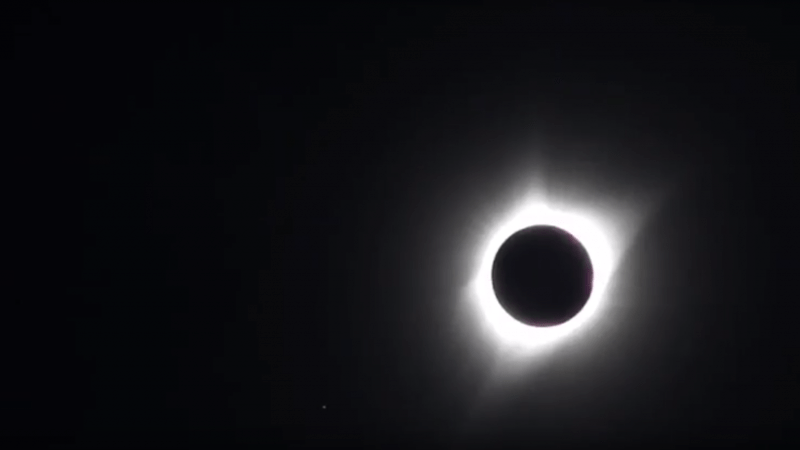

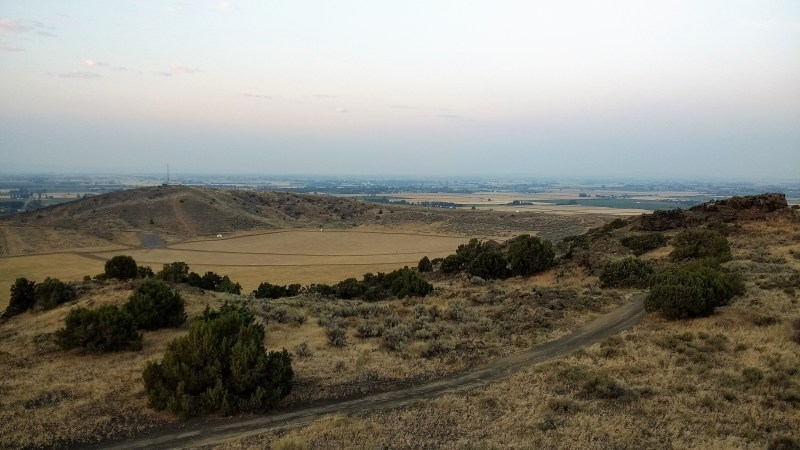
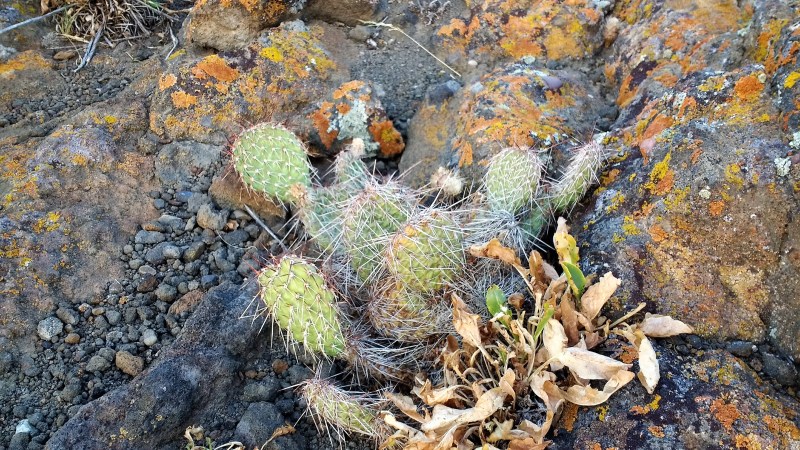
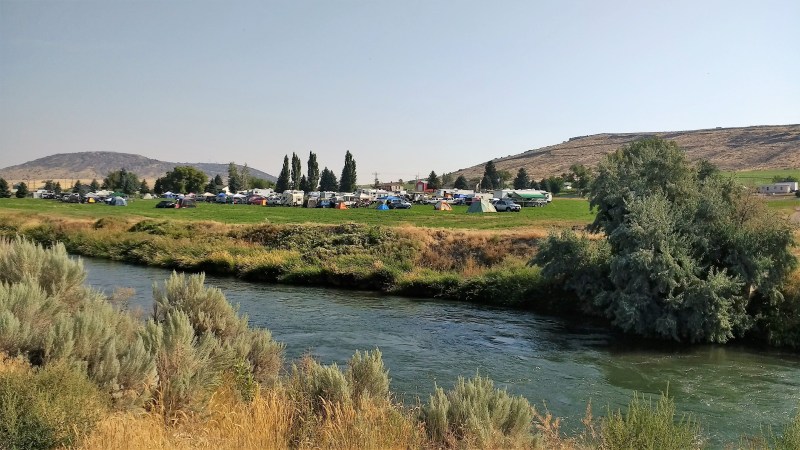

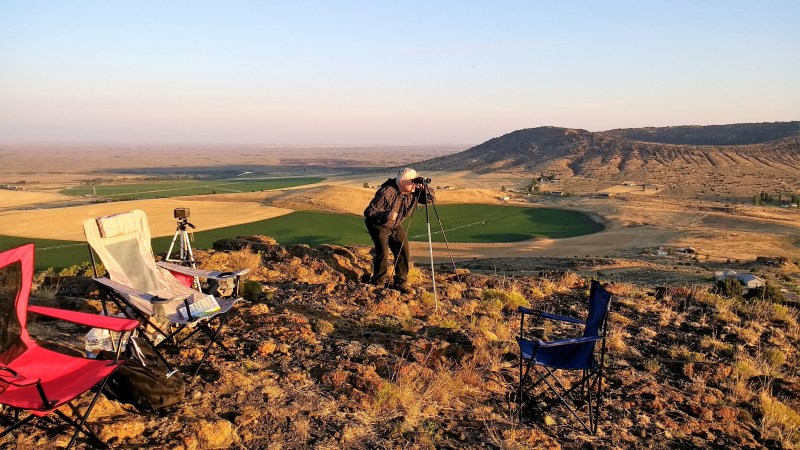

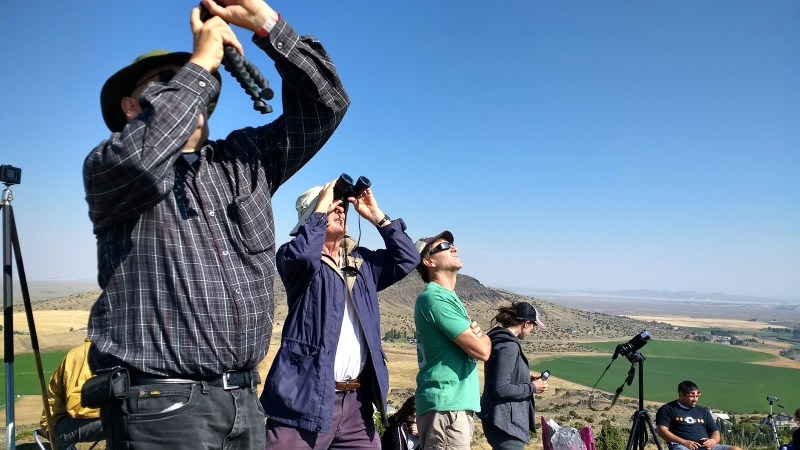














You forgot Wyoming. It is where Destin from Smarter Every Day was at to take photos of the ISS transiting the sun during the eclipse, https://www.youtube.com/watch?v=lepQoU4oek4
Saw that video yesterday. Freaking SWEET. The ISS going across is my desktop background (from NASA, not Destin). Still cool.
We ended up on a stretch of gravel that served as the back entrance from the I-44 North Service road into the St. Clair Missouri Weigh Station opposite the one we had originally intended to use, directly on the line of greatest eclipse. There was only room for about four cars, and there were three when we got there. There was an old guy with professional photo equipment, a family of 5 from Minnesota who drove all the way just for this, and somebody on the end who wasn’t social. We brought our barbeque grill, hamburgers, brats, two gallons of iced tea, three #14 welders glasses, and four “extra” cardboard shades we got from Papa John’s. The family from Minnesota was under-prepared – they had welders hoods with probably #11 shades, dark enough to look briefly but not to stare. We gave them our Papa John’s glasses. They also had a very nice telescope.
As the eclipse progressed, the light got odder and odder. The temperature dropped a bit, but not precipitously. The last few minutes before totality, I mentioned to my wife that it was almost like that feeling just before orgasm – something huge was happening, and you had no control over it. I’m staring through the welder’s glass and the ever-diminishing slice of sun, and suddenly it’s gone – no ring, nothing. For a moment, I’m at a loss – then I drop the glass and see the eclipse, the corona, in all its glory. Like a huge hole in the sky. I can only describe the feeling as “emotional orgasm”. I’ve never seen a total eclipse before with my own eyes. This was so incredibly new and visceral and spellbinding. I took a quick panoramic shot, tried to get a shot of the eclipse but cellphone cameras suck for that.
The family that brought the telescope asked if I wanted to see through it. I ran over, and there it was – the full, beautiful corona, with a major prominence sticking out about 3:00 on the clock face. Incredibly beautiful. I tore myself away from it and urged my wife and son to look, but they declined – and it was too late anyway, as the edge of the photosphere slipped past the moon before they would have been able to reach the scope.
I don’t remember a change in temperature. I don’t remember cicadas, or animals, or birds, or anything. All I remember is that burning ring in the sky. It was without a doubt one of the most beautiful things I will ever experience with my own eyes, unless they figure out commercial space flight for fat guys like me fast.
The panorama mentioned: https://photos.google.com/share/AF1QipMK-WsJzf36beYeDqF_LMyio2m-1IhvpQxl_zdYWGxS0lDe1DHeVQ3PVRb24El_gw?key=U3VDTkNYXy04MTI4Rlp5QjdqcVJ6cHVQV0EwOGtR
Now you know why so much superstition arose around eclipses.
My wife went to Santee SC, on the way up she read an article about the 12 choke points of the eclipse where people could go. The worst was Santee with 75 million people could easily get there. Plus we expected clouds. Well lots of people werre there not 75 million and no clouds at all an hour before and after the total. Really a fantastic time. I wore my HAD shirt but no comments.
Anyone know what Chile/Argentina is like in July. Are the winters in the 2019 eclipse path mild?
Shaky cam video of all the South Menan Butte losers. North Butte is where the party is at https://www.youtube.com/watch?v=WTyJLKQ6hW0
Oh, and the Tetons lighting up as mentioned in the totality video was an amazing part of the show, the light change was fast and dramatic. If you weren’t looking, you missed it.
Here’s what it looked like in Tryon, Nebraska – http://www.komar.org/faq/2017_solar_eclipse_tryon_nebraska/
Pictures/video are cool – being there in person was 100X better! ;-)
Had great viewing conditions on Ankeny Hill Road, Jefferson, OR.
I was on the South Menan Butte and it was great. I came all the way from Slovenia with my family, and thanks to Hackaday we found the perfect spot to view the eclipse. I tried to find the jolly wrencher flag that you mentioned in one of your posts, to say hi and thank you for the tip, but I could not find it.
So I would like to say thank you now – Eclipse on top of the Menan Butte was the best part of our vacations.
That was me you were talking to when you first got there! I was on top of that knob, had my Hacakaday shirt on but it was under my hoodie. No banner — I left it on the RV down in the campground. Sorry we didn’t connect, but glad you were there!
So, I did find you but didn’t know it. Well,… I’ve planned our whole vacations around this eclipse. It was my second one and I will try to catch some more for sure. I enjoyed reading your report, and yes we were really this close – you can actually hear my son shouting “eclipse” in your first video.
It is funny how exciting watching total solar eclipse is, and you are absolutely right about “Where’s the next one?” :)
Wish you good luck with your next one.
Ales
I love reading reports from first-time eclipse viewers. One of my favorites was from a guy who lives in Dundee, Oregon, a mile outside of totality. He and his wife wisely traveled into the path of the shadow in Evergreen where they got 55 seconds of totality. He wrote, “we decided it would be well worth the effort to get ourselves underneath the shadow. It turns out it would have been worth it even if we would have been forced to trek across a frozen tundra via arthritic sled dogs.”
Speaking of an eclipse on the tundra, a gang of us drove from our homes in the Twin Cities of Minnesota to Winnipeg for the 1979 eclipse in February. The weather report the night before had us getting up in the middle of the night to drive west for better weather prospects for the eclipse that happened just before noon. Rural Manitoba in February with the low sun angle of about 25 degrees, and ice in the atmosphere, was outstanding. We still call it our “blue crystal eclipse.”
I now realize how lucky I was with my first eclipse chase, the summer of 1972. A gang of college boys driving from Chicago up through Maine into the Maritime Provinces of Canada, sleeping in youth hostel tents, and watching the eclipse from a sand dune on the shore of Prince Edward Island. All we had was once piece of welder’s glass I bought to look at the partial phases. I was lucky in that we had clear skies and 2:05 of totality, but the real luck was learning not to have cameras or telescopes and allow yourself to be distracted by those things for a solar eclipse.
My brother wrote, “eclipse chasing, like storm chasing (which I did in 2011 in Nebraska), is a crap shoot. You really can’t predict what’s going to happen, but with fast cars and high-speed highways, anything is possible, so you move out “on faith.” He had a $70/night motel 30 miles south of Des Moines and headed out in rain to the path in Missouri on the morning of the eclipse. He ended up driving 200 miles that morning, abandoning his target sight, a nature preserve in Missouri, but did catch a good weather window to experience 2 minutes of totality near Aullville, Missouri.
My base camp was a motel in Kearney, Nebraska, where they served a buffet breakfast at 5:00 a.m. I had breakfast in that hour and then did a Caribou Coffee drive through in the neighborhood that opened at 6:00 a.m. I got two large Caribou iced coffees with a shot of espresso to rev me up for the day ahead. (“Moose It” as they say at Caribou–they call it a “red eye” at the Soho House in Chicago, and a “Harvey Wallbanger” at the Orange Inn in Laguna Beach) I then drove 35 miles east in the 7:00 a.m. hour to my target sight, the Crane Trust tall grass prairie property and Visitor Center along I-80 on the Platte River. There is nothing else at this intersection of the Interstate, and it was near the centerline. It has 10 miles of mowed grassland trails on an expanse of native tall grass habitat that has been unchanged for more than a hundred years. It’s a big destination in the spring when the cranes migrate through.
A cohort of mine, who went on to Casper, stopped at the Crane Center and scouted it for me a week before the eclipse. I got a good piece of advise that accompanied a picture of his bride wearing shorts and smiling in sunshine on one of the grass trails at the Center. She got chiggers. I scouted the place on my way from overnighting in Des Moines, on the Friday before the eclipse, heading to Kearney. I took some pictures with the sun shining exactly 48 hours before totality. I was there as a hiking club was coming back in. A woman gave me her map and a tutorial on where I might set up my camp chair for the eclipse.
I chose Kearney as my base as you could drive 130 miles east to Lincoln, or 100 miles west to North Platte, all on I-80, while staying in the shadow path. Totality along this range ran from 40 seconds to 1:40. I didn’t have to “chase” on eclipse day and experienced what my eclipse app told me at the Crane Center–2 minutes and 33 seconds of totality.
My thanks to everyone at the Crane Center, near Alda, Nebraska, for opening at 7:00 a.m. on eclipse day and hosting more than 500 eclipse chasers. We had high-cirrus clouds and high humidity, but a spectacular viewing experience. For those of you who witnessed totality, and the dream-like illumination in the minutes leading up to it, I don’t need to attempt to write any words to describe the experience. I can simply say, I was there for my fifth eclipse, my first in the U.S., and have already been looking at options for the next ones.
We’ll see you on down that road!
We were also at South Menan Butte and did meet you briefly on Sunday. We took a while to get down Monday and you had already left. We waited what we thought was enough time but still got stuck in 6 hours of traffic. We made the best of it by taking side roads and got to see more of the countryside. Entrepreneurs on the side roads were selling lemonade, water and even were grilling for the people driving by. We had a great time though.
I put some pictures on https://sites.google.com/site/marks2017eclipsephotos/
Mark
Having dodged a few clouds (how better to spend the hours before an eclipse?) we were in a good location west of Casper for a gorgeous view of totality through perfect blue sky. I recommend spending at least some time looking at totality through binoculars – you can really see the dynamics of the corona – in addition, clearly saw Regulus sitting right next to the sun. Also had a lovely 360 degree panorama of the all-round twilight. (Note: binoculars for mid-eclipse only when it’s completely safe, NOT for the diamond ring – it’s too dangerous.)
I was in Lincoln Ne. @ a small area of one of MANY state parks, 30 people or so it was perfect.
The morning began with a severe thunder and lightning and rain by the 5 gallon Home Depot buckets! 50 MILES SOUTH TO LINCOLN (@75 MPH interstate speeds) get to the park. Set up anyway, and one hour before “The Beggining” the clouds parted, the rain stopped and the show began?
And what a show, the park grew dark and gasp went up from the 30 people ! When the space firEworks concluded the wind started back up and the clouds came back just like the curtains on a massive theater screen…..Truly the show was over and it was so worth the price of the ticket stub in your pocket, perhaps indeed, a once in a lifetime viewing…..BUT, WOW, CAN I SEE IT AGAIN……………PLEASE, PLEASE, PLEASE…..